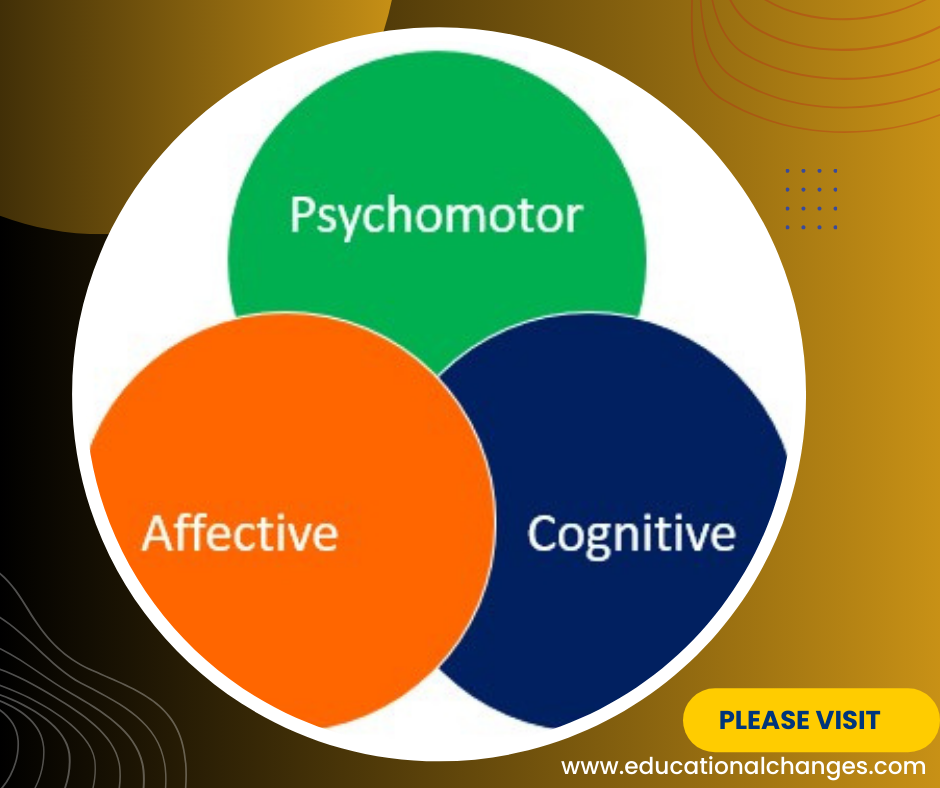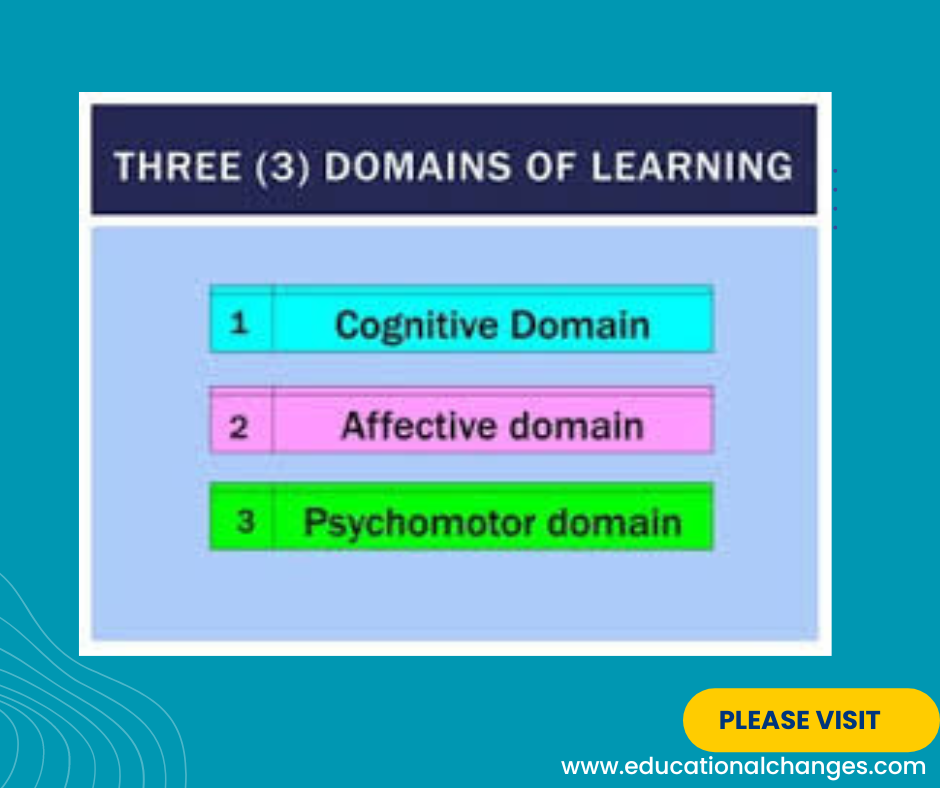
Understanding the domains and Bloom’s Taxonomy
Introduction
domains play vital role in teaching learning process. Bloom’s Taxonomy, a foundational framework in education, outlines three crucial learning domains: cognitive, effective, and psycho-motor. These domains, often represented as the head, heart, and hand respectively, signify different facets of learning. Developed by Dr. Benjamin S. Bloom and his team of educational psychologists in 1956, this taxonomy provides educators with a structured approach to teaching and evaluating learning objectives across these domains.

The Cognitive Domain: Engaging the Mind
The cognitive domain often referred to as the “head,” focuses on acquiring knowledge and comprehending concepts. It spans various levels of thinking, from basic recall to higher-order cognitive skills like analysis and synthesis. Educators leverage this domain to design activities that foster critical thinking and problem-solving, facilitating deeper understanding and intellectual growth among learners.
The Effective Domain: Nurturing the Heart
Incorporating emotions, attitudes, and values, the effective domain, symbolized as the “heart,” acknowledges the significance of personal experiences in learning. Educators recognize the importance of cultivating positive attitudes and empathy through reflective practices and collaborative learning, fostering social and emotional skills crucial for holistic development.
The Psycho-motor Domain: Developing Manual Skills
Represented as the “hand,” the psycho-motor domain emphasizes the acquisition of physical skills and coordination. From basic tasks like tying shoelaces to mastering complex motor skills in sports or crafts, educators design hands-on activities to facilitate skill development and confidence among learners.
Understanding the Three Learning Domains
Introduction:
Exploring the intricacies of learning unveils a multifaceted process that encompasses various domains. Among these, the three primary learning domains—cognitive, psychomotor, and affective—play pivotal roles in shaping our understanding and mastery of knowledge, skills, and attitudes. Delving into each domain reveals distinct characteristics and implications for educators, learners, and educational systems.
Understanding Cognitive Domain:
At the core of intellectual development lies the cognitive domain, which encompasses the acquisition and utilization of knowledge through mental processes. It involves the learner’s ability to comprehend, analyze, synthesize, and evaluate information. From basic recall of facts to the application of complex problem-solving strategies, the cognitive domain is fundamental to educational success.
Bloom’s Taxonomy: A Framework for Cognitive Development
Bloom’s Taxonomy provides a comprehensive framework for understanding cognitive processes, ranging from lower-order thinking skills such as remembering and understanding to higher-order skills like evaluating and creating. This taxonomy serves as a guide for educators in designing learning experiences that promote cognitive growth across various levels of complexity.

Exploring the Psycho-motor Domain:
While cognitive development focuses on mental faculties, the psycho-motor domain centers on the acquisition and refinement of physical skills and coordination. From simple actions like grasping objects to intricate movements in sports or performing arts, this domain encompasses a wide spectrum of activities that require motor proficiency and dexterity.
Skill Acquisition and Motor Learning:
Understanding how individuals learn and refine motor skills is essential for effective instruction in the psycho-motor domain. Factors such as practice, feedback, and motor memory contribute to skill acquisition, highlighting the importance of structured learning experiences and deliberate practice in mastering physical abilities.
The Effective Domain: Shaping Attitudes and Values
Embracing the Effective Domain:
In addition to cognitive and physical development, education also seeks to cultivate attitudes, beliefs, and values through the effective domain. This domain encompasses the emotional and social aspects of learning, influencing learners’ motivation, self-perception, and interpersonal relationships.
Fostering Emotional Intelligence and Empathy:
Educators play a crucial role in nurturing emotional intelligence and empathy within the effective domain. By creating a supportive learning environment and integrating activities that promote self-awareness and social competence, educators can help learners develop emotional resilience and empathy towards others.
Crafting an Effective Domain Strategy
Introduction:
In the expansive realm of the internet, a domain name serves as the digital storefront for businesses and individuals alike. Crafting an effective domain strategy is crucial for establishing online presence, attracting visitors, and achieving desired outcomes. Through strategic selection and utilization of keywords, businesses can enhance their visibility and resonance within their target audience.
Choosing the Right Domain:
Selecting a domain name involves more than just creativity; it requires foresight and consideration of keywords relevant to your niche. Integrating relevant keywords into the domain can significantly enhance search engine optimization (SEO) efforts, increasing the likelihood of appearing in relevant search results. For instance, if you’re a bakery based in New York, incorporating keywords like “NYC bakery” or “New York pastries” can attract local customers actively seeking such services.
Strategic Keyword Placement:
Incorporating keywords strategically within the domain name enhances its visibility and relevance to search engines. Placing keywords at the beginning of the domain name tends to have more impact, as search engines prioritize the initial segments of URLs. However, it’s essential to maintain a balance between keyword optimization and brand identity, ensuring the domain remains memorable and reflective of the business’s essence.
Domain Extensions and Relevance:
The choice of domain extension also plays a vital role in establishing relevance and credibility. While .com remains the most popular and trusted extension, other extensions such as .org or .net may be more suitable for specific purposes, such as non-profit organizations or networking platforms. Selecting the appropriate extension reinforces the domain’s purpose and instills trust among visitors.
Consistency across Platforms:
Maintaining consistency across various online platforms reinforces brand identity and facilitates user recognition. Utilizing the same domain name across social media profiles, email addresses, and business listings fosters coherence and simplifies the process for users seeking information or engagement.
.










I do agree with all of the ideas you’ve presented in your post. They are very convincing and will definitely work. Still, the posts are too short for newbies. Could you please extend them a bit from next time? Thanks for the post.
Hi this is somewhat of off topic but I was wanting to know if blogs use WYSIWYG editors or if you have to manually code with HTML. I’m starting a blog soon but have no coding expertise so I wanted to get guidance from someone with experience. Any help would be enormously appreciated!